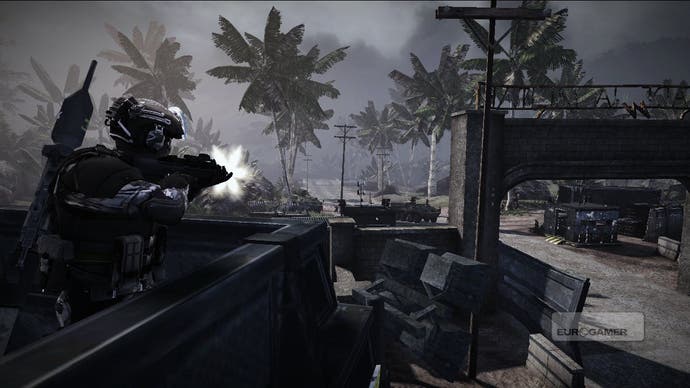MAG
The future of the multiplayer shooter?
When Sony revealed MAG - no-one's referring to it as Massive Action Game any more, it seems - at E3 last year, its promise of 256-player online modern warfare raised a few eyebrows. Not that we didn't believe it; we did, however, wonder how it could possibly hang together. Even in MMOs, you rarely get that many people in a single conflict, and when it does happen (in EVE Online, say) precious few understand what's going on, or can perceive it through the juddering lag. Surely a multiplayer FPS on that scale could only go one of two ways: complex, tactical and dry, or sheer bloody chaos.
Zipper Interactive knows better. After 12 games in 13 years, most of them in Sony's quietly huge SOCOM series (racking up 10 million sales to date), it should. And just because it has a history in military training software doesn't mean it doesn't understand the meaning of fun.
MAG is fun. In fact, it's massive fun. It's fast and loose, free-flowing, improvisational, spectacular, structured without being too rigid; it accommodates lone wolves, team players and power-trippers alike, and makes it easy for players themselves to direct the action. You'd expect it to be intimidating, but it actually feels like the FPS for everybody. Even after just one 20-minute, 128-player match, it's hard to shake the feeling that, one day, all multiplayer shooters will be made in its image.
In a way, the concept is very simple. Zipper takes that scary number of players, breaks it down into something friendly and familiar - squads of eight facing off in 16-player struggles for an objective or two - and then builds it up again. 16-player skirmishes segue smoothly into 32-player firefights as squads converge. Then 32 players become 64 as attackers and defenders move on from subsidiary to primary objectives. Then you look over a hill, or a building, and see the mirror image of the battle you're fighting on the other side of the map. Then it happens again.

"If you're talking sheer chaos, in terms of, if you drop 256 players into a village square like an arena, that's going to be unmitigated," says creative director Ed Byrne. "So what we wanted to do is build that intensity and use that flow to direct players from small encounters to larger, and to basically make sure that squads link up actually more like a realistic military operation."
Orchestrating battles on this scale involves a light touch, he explains. You need to direct the fight through careful level design, but also leave players freedom to spread out. "It's through level design and through the flow from beginning to end of the map as you go through the objectives that we mitigate the chaos. The other [method] is simply allowing players to have some freedom on where to go, so if a player is basically overwhelmed by the amount of combat that he's seeing, he can not only retreat backwards but he can go laterally and join the areas that are happening on either side of him."
There'll be a benefit to sticking with your squad, however. 64- or 128-man armies are divided into eight-man squads and 32-strong platoons, and each of these is assigned a leader, with the OIC (Officer In Charge) sitting at the top. Squad and platoon leaders have special skills, ranging from team buffs to tactical support (artillery strikes, A10 strafing runs - big bangs, basically) to powerful strategic manoeuvres like satellite sweeps or blockades.

Perhaps more importantly, they can set FRAGO (fragmentary orders) objectives. These clearly direct players to primary and secondary objectives on the map: disable this anti-air gun so we can call in airstrikes, take over this bunker so the enemy can't use it as a spawn point, steal this experimental vehicle to win the game. You get double the experience points for focusing on FRAGO objectives, and big bonuses for actually completing them, so your character ranks up faster. Ranking up unlocks weapons, develops your skills in the three class disciplines - medic, engineer and assault - and, eventually, grants access to those command roles. It's a virtuous circle that doesn't force organised play, but rewards it at every level.
"Part of the fantasy of scale on one end of the spectrum is being a soldier, being an operative in that large battle," says Byrne. "But for many players the fantasy on the other end of the spectrum is being in charge. And we wanted to make sure that when we dealt with scale, we weren't simply, again, just dropping people into an arena and having them fight each other. We wanted the fantasy fulfilment to be on the leadership side as well, for the admittedly, probably smaller number of players who want to be OICs - to give them the opportunity to participate on a more strategic level."
Even OICs are warriors on the ground, however. There's a neat 3D tactical map that every player can view, but only commanders can interact with, setting objectives and deploying assets. But there's no separate, high-level RTS-style view of the action. "We didn't want them basically to get stuck in there like they're playing a map," says Byrne. "So OICs and platoon leaders and squad leaders are all able to, and encouraged to, basically be in the field fighting, and then juggle their duties behind the gun and behind the interface in terms of their play-style."








